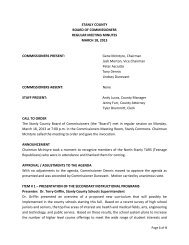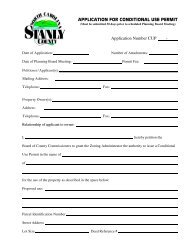Land Use Plan – 2002 - Stanly County, North Carolina
Land Use Plan – 2002 - Stanly County, North Carolina
Land Use Plan – 2002 - Stanly County, North Carolina
Create successful ePaper yourself
Turn your PDF publications into a flip-book with our unique Google optimized e-Paper software.
Strengths<br />
Weaknesses<br />
STANLY COUNTY<br />
1. Identify the land that should be permanently protected based on a specific site analysis and<br />
also the communities’ values. The precise location of features to be preserved such as<br />
wetlands, floodplains, steep slopes, woodlands, stream corridors, farmland, scenic views,<br />
etc. should be noted. The balance of the site becomes “potential development areas.”<br />
2. Identify the specific location for housing sites, within the potential development areas, so as<br />
to maximize their view of open spaces and natural features.<br />
3. Layout the streets and informal pedestrian trails that access the developed areas.<br />
4. Record permanent conservation easements on the open space lands’ title documents (Rural<br />
by Design).<br />
The following strengths have been associated with the conservation development model:<br />
Preserves a high percentage of natural features (e.g., woodlands, steep slopes, viewsheds,<br />
streams and rivers) and open spaces for the community as valuable features are identified<br />
and accommodated within the design process.<br />
Market based pricing for homesites as there is no government regulation of the prices.<br />
The existing underlying / full densities is retained on the site. The density is clustered within<br />
smaller areas of the site rather than spread out throughout the entire site.<br />
Is an efficient use of suitable lands for development as septic fields are located in areas with<br />
well drained soils rather than spread the drain fields throughout the site including in areas<br />
with poorly drained soils.<br />
The design parameters are voluntary, or if the community desires, could become mandatory<br />
under certain criteria such as sites that are larger than a certain size.<br />
No public expenditures are needed to preserve lands as developer and homebuyers create<br />
the open spaces by buying homes that are clustered together.<br />
The program is simple to implement because only one landowner/developer is needed per<br />
site.<br />
The design principles reduce development costs by concentrating development on the site<br />
and minimizing road and infrastructure costs.<br />
Reduces possible government review costs by not necessarily crossing wetlands etc. and as<br />
a result eliminating the need for government review of wetlands crossing/mitigation.<br />
Site plan review time is not any more stringent of a process than what currently exists for<br />
subdivision development.<br />
The following weaknesses have been identified for the conservation development/design model:<br />
Not necessarily the appropriate model to protect farmland except on a site-by-site basis.<br />
Could potentially introduce nuisance complaints from homeowners where it is used<br />
alongside agricultural areas.<br />
<strong>Land</strong> <strong>Use</strong> <strong>Plan</strong> 6-17 6/02






